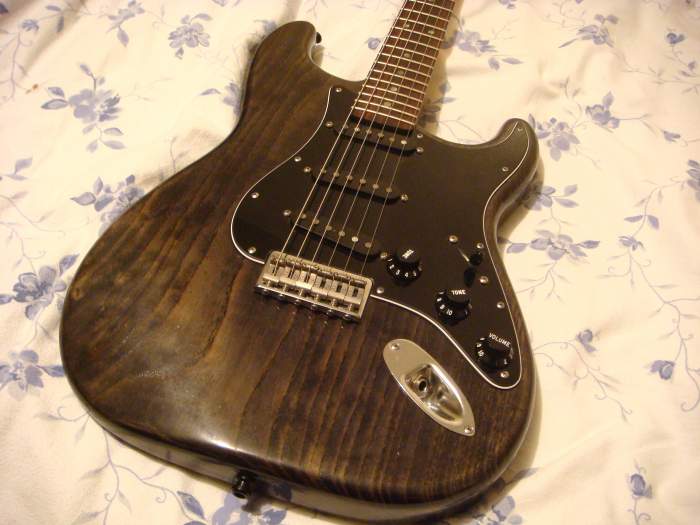Legatt
Newbie
- Messages
- 3
Hello (Unofficial)Warmoth, I am new to the forum, but not new to building and assembling. I have experience with various finishes, woods, parts, etc. But I want to create a step by step guide for myself, for when my warmoth Alder P Bass body arrives, because I don't want to make decisions I'll regret. So I need your help assembling this instruction manual.
GOAL: Achieve a walnut-colored gloss finish with an alder body, like the following image, but glossier:

PLAN: To use minwax wipe on poly gloss finish, over minwax walnut stain. Grain fill, wet sand/slurry method.
MATERIALS: Sandpaper of all grits, sanding sponges, a sanding block, wet/dry paper, 0000 steel wool, naptha (for thinning/cleaning) shop towels, and rags.
STEP BY STEP: please tell me if I'm wrong. I don't mind criticism of correction at all!
1. Sand new body up to 400 grit.
1a. Raise grain with naptha to check for sanding errors. Correct any I find.
2. Pore fill with joint compound per this video. I have heard mixed things about alder and pore filling. If it is not needed for a smooth, gloss finish, let me know.
2a. Push joint compound into surface. Wipe off excess. Let dry.
2b. Sand the surface and excess joint compound down to 400.
3. Use minwax dye. Let sink for a bit. Wipe off excess.
3a. Allow to dry. Apply additional coats of dye if necessary.
4. Apply first goat of poly. Apply thickly. Wet sand with 400+ wet/dry sandpaper.
4a. Push sanding slurry into grain.
4b. Wipe off excess poly/slurry. Allow to dry
4c. Lightly sand finish at a grit above 400.
5. Apply next coat of poly, wipe off excess.
5a. Lightly sand finish coat at a higher grit.
6. Repeat until final gloss/coat is achieved.
GOAL: Achieve a walnut-colored gloss finish with an alder body, like the following image, but glossier:
PLAN: To use minwax wipe on poly gloss finish, over minwax walnut stain. Grain fill, wet sand/slurry method.
MATERIALS: Sandpaper of all grits, sanding sponges, a sanding block, wet/dry paper, 0000 steel wool, naptha (for thinning/cleaning) shop towels, and rags.
STEP BY STEP: please tell me if I'm wrong. I don't mind criticism of correction at all!
1. Sand new body up to 400 grit.
1a. Raise grain with naptha to check for sanding errors. Correct any I find.
2. Pore fill with joint compound per this video. I have heard mixed things about alder and pore filling. If it is not needed for a smooth, gloss finish, let me know.
2a. Push joint compound into surface. Wipe off excess. Let dry.
2b. Sand the surface and excess joint compound down to 400.
3. Use minwax dye. Let sink for a bit. Wipe off excess.
3a. Allow to dry. Apply additional coats of dye if necessary.
4. Apply first goat of poly. Apply thickly. Wet sand with 400+ wet/dry sandpaper.
4a. Push sanding slurry into grain.
4b. Wipe off excess poly/slurry. Allow to dry
4c. Lightly sand finish at a grit above 400.
5. Apply next coat of poly, wipe off excess.
5a. Lightly sand finish coat at a higher grit.
6. Repeat until final gloss/coat is achieved.


